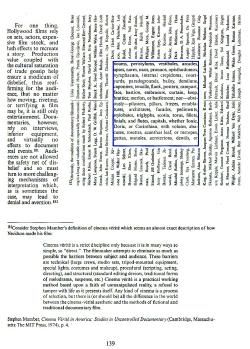Main Points
House of Leaves is a text that is difficult to write about, because it's a work that has already been interpreted for us, within the text and outside of it. Zampano includes footnotes that analyze the behavior of the characters in The Navidson Record, and Johnny Truant himself is responsible for compiling, editing, and, in some instances, altering the source material. The layers of mediation (remediation) in House of Leaves creates ambiguity and confusion, making it hard to really analyze the text from a literary standpoint, which is why most critics seem to focus on the complex typographical structure of the book as a whole. However, we can try to use specificity as a way to beat the layers of mediation. Focusing on a theme or one storyline or one image can help a writer stay focused on a paper and not get lost in the unending amount of information. House of Leaves is also difficult to analyze in that it's encyclopedic--there is a ton of information that is thrown at the reader and it's practically impossible to write about it all.
How is House of Leaves satire?
- Pokes fun at academia
- Footnotes and interviews are abundant, but contribute very little to the book, other than Johnny's extensive footnotes.
- Mocks the editing process
- There are passages that are marked out, and covered in ink, accentuating the process which typically remains unseen.
- Academic paraphernalia
- Appendices
- Extremely complex index
- Intense psychoanalysis
- Pages literally take on the shapes of what they are depicting (ex: the labyrinth)

Although House of Leaves is a confusing, inefficient, layered novel, it is meant to be this way and that is part of the fun. We are supposed to feel frustration while reading it. The novel reminds us that the book is still relevant and there is still more to be done.

Ethics of Representation (or mediation) vs. Reality
- The question is, is it 'right' to take photographs like the Delial/Kevin Carter one?
- As a viewer
- teaches us the realities of human suffering, so the photo is sending a message in order to cause change.
- As a photographer
- Taking photographs is a job, so, in that case, it's not 'unethical' or 'ethical.'
- Its purpose is to be unsettling, and if it succeeds then hopefully a greater purpose is met.
The dilemma comes when we see that good can come from the photograph, yet at the cost of a life. Our job as a human being is to help others, and to see someone clearly suffering and to do nothing is 'inhumane.' Yet, photographers were often told not to touch those they were photographing because of fear of disease. Should one risk one's own life, when there may be nothing to do that can actually help the sufferer? Perhaps the picture is the only way of helping at all. Even so, some cannot escape the guilt for following the rules-ex: Carter (or Navidson).
Difference between Digital Photography and Film
- Roland Barthes
- With film, light actually touches the film, so it becomes something physical, and thus, more real.
- Digital Photography
- There is the possibility is has been altered with computers, makes it carry less impact. The impact from a photo comes from seeing something real captured. The moment is gone if it no longer seems real.
- Element of mass reproduction.
- Walter Benjamin in 1936 wrote about mechnical reproduction -- that to reproduce is to diminish the 'aura' of the original.
- he means that it takes away the 'ahh' factor of the Mona Lisa if it can be reproduced in mass quantities.
- However, as with the picture of a woman with cancer that we discussed in class, mass reproduction can also send a message to a large amount of people, and the impact is not lost, it is just of a personal nature.
Terms
Centripetal: “Inward”. Describes an apparent movement or tendency to move toward a center, inward from without ("Glossary," 2005). Mark Z. Danielewski in the interview "Revolution 2" with Kiki Benzon describes House of Leaves as a "centripetal book": "[House of Leaves is] about interiorities and history and progeny and ancestors." The story collapses towards the center of the novel -- the characters, and the reader, just move further into the story rather than away from it.
Ethics: Is the study of the principles of 'right' and 'wrong.' Morals / Morality; The "standards that govern the conduct of a person, especially a member of a profession" ("ethics," Wiktionary).
Paratext - text that provides a framework for the written text ("Paratext," Wikipedia). Ex: Author's name, title page, index, introduction, illustrations, etc. These function in order to present the text, to frame it--to, in essence, make the book a book. (As defined by Gerard Genette).
Danielewski implements paratext in order to, as Genette states, fashion House of Leaves as a book--to emphasize the construction of the medium. However, Danielewski also uses the paratext in order to enhance the story within, which contradicts Genette's assertion that the paratext is really inconsequential.
Satire - a work that mockingly criticizes society. Examples: "The Colbert Report," "A Modest Proposal" by Jonathan Swift, The Onion, "Saturday Night Live," etc.
Passages
"Academia soon marched in to interrogate the literary consequences created by the Delial revelation." (394)
This quote is significant in that it alludes to the satirical element of House of Leaves. Here, academia is directly referenced, and its about the analysis of the prize-winning photograph that haunts Navidson--one that is based on Kevin Carter's Pulitzer Prize winning photo from 1994. The editors remark in footnote 336 that the photo in The Navidson Record is based on Carter's photograph, which, in effect, casts doubt upon the validity of the film/book as a whole. Furthermore, Academia discussed its literary consequences. They did not care about the child or the plight, simply what it meant to Navidson's psyche and guilt. This can be seen as the insensitivity of Academia, foregoing any human responsibility in favor of analysis.
"The book is burning. At last. A strange light scans each page, memorizing all of it even as each character twists into ash." (518)
This passage also draws the reader's attention to the book's role within the story, which the writer(s) do frequently in varying degrees of subtlety. If Johnny burns the book, how do we have copies? This passage adds to the frustration the reader feels in trying to dissect the many layers of House of Leaves, while also mocking the process of creating and distributing books. Danielewski wants to reader to question how one obtains a book which has been burned by one of the authors (simultaneously emphasizing the spooky quality of the text itself -- if it's been burned, how can it possibly exist?). Then the reader must also question who else contributed to the book and how they got access to the material if Johnny Truant burns the last copy.
"See Liza Speen's Images of Dark; [...] as well as some of the photographys by Lucian Aigner, Osbert Lam, Cas Oorthuys [...]" (fn. 75 on page 64-67)
This footnote satirizes academic convention by having an inordinately long list (even the last names themselves acrostically spell out A-L-O-N-G-L-I-S-T); additionally, this footnote focuses on photographs--a recurring motif in House of Leaves. Throughout House of Leaves, an emphasis is placed on Will Navidson's ability to shape and frame reality with his camera; this is a part of the remediative layering of the novel. The entirety of the novel, at its core, centers around The Navidson Record--which Zampano writes. This manuscript, in turn, falls under Johnny Truant's hands as he attempts to recreate the manuscript (subsequently losing his mind, or was he insane to begin with? Or did he exist at all, insane or not?). In addition, photographs, esp. in this new day and age, bring into question the validity of what we see. Photographs can be digitally altered--so we can't necessarily believe what we are seeing.
Links
Time's Rendition of Kevin Carter: Time Magazine's article on Kevin Carter after he received the Pulitzer Prize and committed suicide.
The Bang Bang Club: In tandem with the above link on Kevin Carter, here's a really good video on the group of photographers he worked with who were called the Bang Bang Club, so named cause their subject was the violence before the 1994 democratic elections in South Africa.
Ethics for Photojournalists: The National Press Photographers Association Code of Ethics.
House of Leaves as an ARG: One man's blog about ARGS, including a section about House of Leaves as a mini-ARG.
TV Tropes: House of Leaves: The TV Tropes page on HoL (all the instances of "house" on this page are highlighted blue). This page lists many of the common tropes in the novel, some of these include: Creepy Child, Fictional Media, Literary Agent Hypothesis, No Fourth Wall, Unreliable Narrator, What Do You Mean It's Not Symbolic, The World Tree, and many more.
TV Tropes: World Tree (motif): On TV Tropes, there's actually an entire page dedicated the the World Tree, aka Yggdrasil, and its significance in media.
From the entry on the World Tree:
"The Tree seems to represent the connection that all living things have. It is present when two people make a promise. It is also present just beyond life, where all souls come together. (So it can also represent Eternity.) If something happens to the World Tree, often a new one will be born from a seed; representing rebirth."
Revolution 2: An Interview with Mark Z. Danielewski: Electronic Book Review interview by Kiki Benzon with MZD about his new book Only Revolutions. One quote in particular that discusses MZD's literary influences:
"I see House of Leaves as a journeyman's piece. It's very connected to the authors I studied, whether it was Borges or Nabokov, Virginia Woolf or Sylvia Plath, whether it was Bukowski, Fuentes or Kerouac. There are all sorts of obvious predecessors to it. There's a lot of classical stuff and litcrit in there. But for me it was a synthesis of all that. Only Revolutions is different. It goes beyond what you can anticipate in academia. It requires a new kind of nomenclature, I think, to address it. It asks a lot of the readers. But it's a much more refined piece, a lot more work went into it. It's a lot scarier, when you get into its depths, than House of Leaves is." (Danielewski qtd. in "Revolution 2")
Also, MZD refers to HoL as a "centripetal" book -- one about "It's about interiorities and history and progeny and ancestors", whereas OR is a "centrifugal" book.
Citations
"ethics." Wiktionary. 10 Dec. 2008. <http://en.wiktionary.org/wiki/ethics>
"Glossary." Himalayan Living Salt. 2005. 10 Dec. 2008. <http://www.himalayanlivingsalt.com/glossary.htm>.
"Paratext." Wikipedia. 10 Dec. 2008. <http://en.wikipedia.org/wiki/Paratext>
Comments (1)
Kara Z said
at 2:36 pm on Dec 9, 2008
Come on group! We need to work to finish up our wikis!!
You don't have permission to comment on this page.